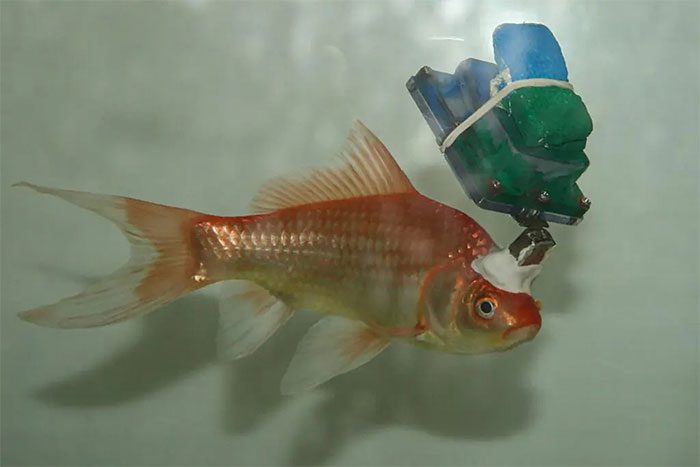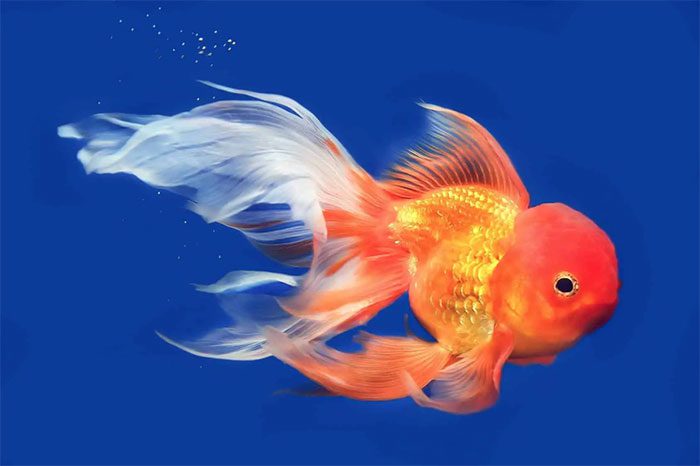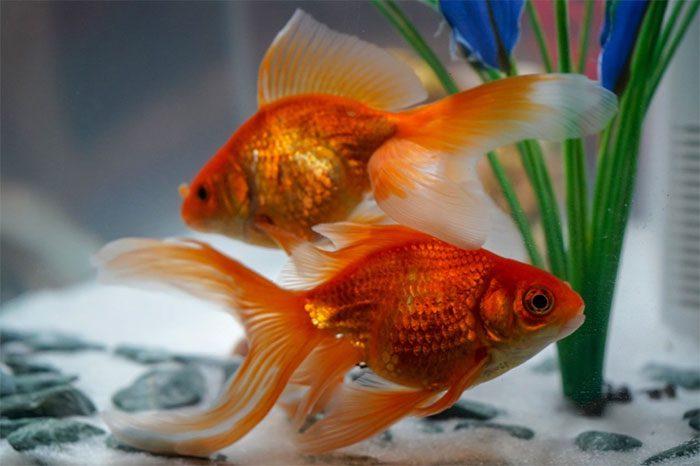A recent experiment conducted by neuroscientists has verified that the way goldfish navigate differs from that of most mammals, likely due to the use of a different neural pathway than is commonly found.
The striking hat resembles the eye-catching handmade fashion items seen at the famous Kentucky Derby horse race. But more than that, the hat is part of a “cyborg” goldfish.
The term “cyborg goldfish” refers to the enhancement of the goldfish’s motor functions through technological solutions.

Scientists performed brain surgery on the goldfish to implant electrodes through small holes in the fish’s skull, leading to a recording device mounted on its head that can monitor neural activity. (Photo: New York Times).
Brain Surgery and Electrode Implantation
The scientists did not attach this device for fun: They are studying how the goldfish’s brain navigates and the mechanisms involved in the development of orientation in all creatures with a nervous system.
Ronen Segev, a neuroscientist at Ben-Gurion University of the Negev in Israel and a member of the study published on April 25 in PLOS Biology, discussed implanting experimental hats on 15 goldfish, stating: “Orientation is an extremely important ability for the survival of certain species as it helps them locate food, find shelter, and avoid predators.”
Implanting devices into goldfish to study how their brain’s neurons function during navigation is no easy task.
Great care is needed because a goldfish’s brain, resembling a tiny cluster of lentils, is only slightly longer than 1 cm.
Lear Cohen, a neuroscientist and Ph.D. candidate at Ben-Gurion, performed the surgery to attach the devices and noted: “Under the microscope, we opened the brain and placed the electrodes inside. Each electrode has a diameter no larger than a human hair.”

It is challenging to conduct graft experiments on fish because “fish need water and you need them not to move.” (Photo: Fishkeeping World).
It is also quite difficult to carry out this procedure in a dry area without harming the test subjects. “Fish need water and you need them not to move,” he explained. He and his colleagues addressed both issues by pumping water and anesthetics into the fish’s mouth.
Once the electrodes were implanted in the brain, they were connected to a small recording device that could monitor neural activity and was sealed in a waterproof box affixed to the fish’s forehead. To prevent the device from weighing down the fish and hindering its swimming ability, the researchers added a floating foam section.
Interesting Discoveries
After recovering, the fish debuted its new look with a head-mounted hat. The experiment allowed the goldfish to swim in a tank that was 60 cm long and 15 cm wide. The closer the fish swam to the edge of the tank, the more active the orientation cells in their brains became.
The device implanted in the fish’s brain revealed that goldfish use an entirely different orientation system than what scientists have found in mammals. For humans (and other species in the same class), orientation cells often pinpoint our exact location in the environment and create a mental map around that position. Mammals have specialized neurons that create positioning pins indicating “you are here” on their subconscious maps, but the researchers did not find these cells in goldfish.
Instead, goldfish rely on a type of activating neuron that informs them when they are approaching boundaries or encountering obstacles. By combining information about distances from various barriers, the fish can navigate in space.

The way the orientation cells in fish function is somewhat different from the norm. (Photo: The Spruce Pets).
Dr. Segev explained that the navigation system in mammals includes cells that allow an animal to determine that “I am here, I am here, I am here.” He noted that in goldfish, the cells function to convey a different stream of information: “I am at this position along this axis, and this position along another axis.”
Mr. Cohen speculated that the neurological variations in orientation in animals could be a result of the different adaptations they face while navigating their environments. For example, he said, in a watery area where the flow is constantly changing, fish would “easily perceive distances from a specific point in the environment rather than from an exact location.”
All experiments were approved by the university’s animal welfare committee, so the researchers euthanized the fish after swimming to further examine their brains. The team hopes to learn more about how and why the orientation systems of fish differ from our own.
Adelaide Sibeaux, a biologist at the University of Oxford who did not participate in the study, expressed that she finds the project “quite amazing” and significant.
Dr. Sibeaux shared: “We are changing the environment of many animal species, and if you understand how a species navigates, you will know whether they can cope with the changes happening in the world right now. For instance, in the case of fish, this explains whether they can adapt to the murky vision caused by water pollution.”


















































